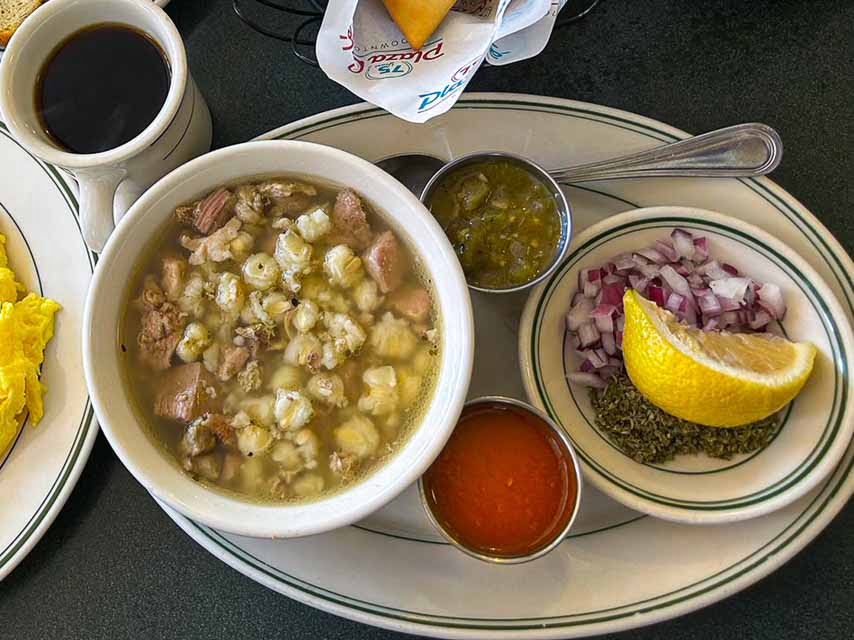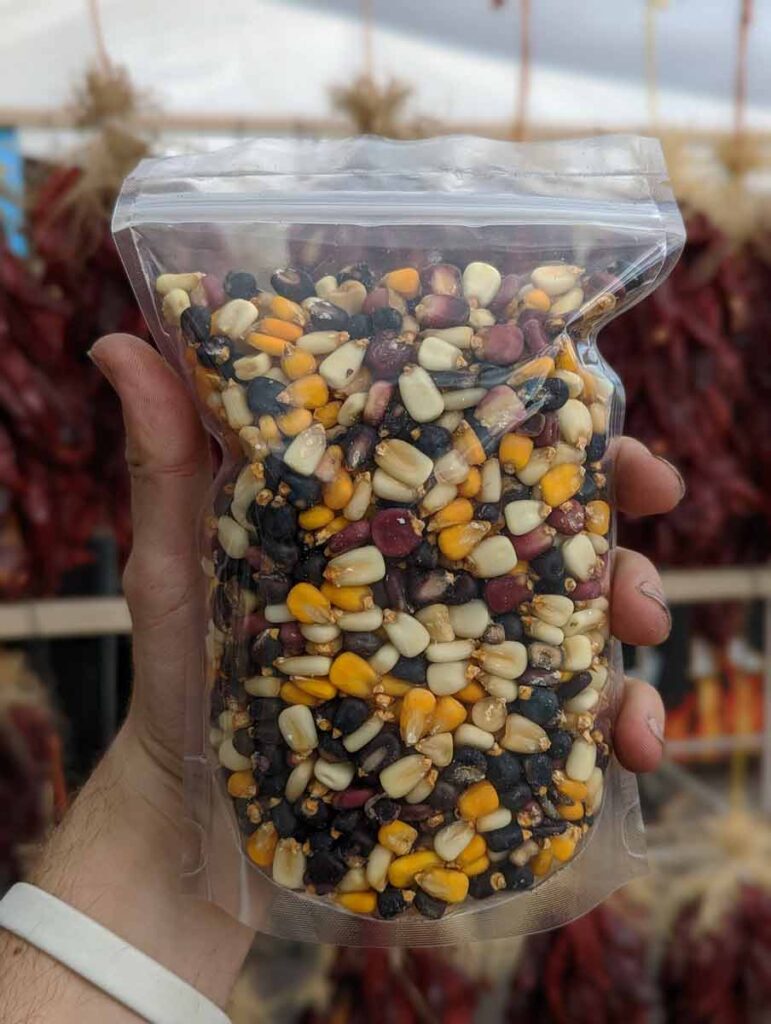Your cart is currently empty!
What is Posole

Posole, a nixtamalized corn dish, has been a staple food in Mesoamerica for centuries, evolving into diverse and delicious regional variations across Mexico. Beyond the rich history of the dish itself, each variation carries further regional influences, local flavors, and cultural connections.
If you are in New Mexico or old Mexico, you will no doubt see posole on many menus, especially if the weather is cold. Also spelled pozole, the name doubles as an ingredient and a soup. The ingredient itself is a nixtamalized corn, similar to hominy. As we aren’t a restaurant, we focus mainly on the dried form of posole. It is a fantastic ingredient in soups, but can also be used in salads, or ground up to make corn tortillas. It is a truly versatile ingredient, which is healthy and filling.
Other corn products in NM
Corn products have long been a very important part of New Mexican cuisine, and posole or hominy is just one aspect of corn in New Mexican food. Chicos del horno is another very popular corn ingredient we use They kick up the flavor in a bowl of beans to another level! Keep in mind that chicos take much longer to cook than dried pozole, so start cooking chicos at least an hour before you add the posole kernels in!
Posole the soup
The soup has many different varieties in Mexico, with soup colors ranging from green, to red, to even black, often incorporating chicken or pork. In New Mexico, the typical soup is made with red chile and pork, often accompanied by a tortilla. This hearty soup is full of nutrition, as the process to turn corn into posole unlocks a lot of vitamins and minerals from corn that we are unable to digest normally. More than just being healthy, the soup warms one’s bones on cold winter days. If you ever travel to the balloon fiesta in the morning, be sure to try some posole and see how warm it keeps you.
Types of Pozole popular in Mexico
1. Red Posole (Pozole Rojo)
Vibrant and flavorful, red posole gets its bold color and spice from red chiles. Popular in the state of Guerrero and in New Mexico, the sauce is made with chiles like guajillo or ancho (or New Mexico’s hot Sandia or extra hot Barker chiles). This base simmers with cooked hominy, tender pork, and a blend of spices. Garnishes like fresh shredded lettuce, radishes, avocado, and lime add vibrancy to the hearty stew. Red chile pork posole is beloved in New Mexico, where it’s a common Christmas dish and a way to warm up during winter.
2. White Posole (Pozole Blanco)
A lighter take on posole, pozole blanco hails from Jalisco and Nayarit. The clear, flavorful broth features herbs like oregano and bay leaves. Hominy corn and meat (usually chicken or pork) are cooked until tender within. White posole is often served with toppings like diced onions, chopped cilantro, and lime wedges, allowing diners to customize the flavors.
3. Green Posole (Pozole Verde)
This variety is instantly recognizable by its vibrant green sauce, typically found in Guerrero and Michoacán states. The sauce is made by blending green chiles, tomatillos, cilantro, and garlic, leading to a fresh, tangy flavor. Tender meat, usually chicken or pork, and hominy corn round out this colorful variety. Garnishes like sliced radishes, avocado, and a squeeze of lime add extra brightness. Increasingly popular in New Mexico, green posole is sometimes made by blending green chile sauces with a traditional white posole base for a unique regional take.
4. Seafood Posole (Pozole de Mariscos)
Seafood lovers delight in this variation popular in coastal regions like Baja California and Sinaloa. Pozole de mariscos features a medley of fresh seafood like shrimp, fish, and clams. A combination of rich fish stock and tomato sauce creates a savory broth base, perfectly complementing the delicate seafood flavors. Garnishes like chopped cilantro, diced onions, and a squeeze of lime bring additional vibrancy.
5. Vegetarian Posole (Pozole Vegetariano)
This meatless option offers a delicious and satisfying twist on posole. Vegetarian posole is cooked in a vegetable broth seasoned with herbs and spices like cumin, paprika, and chili powder. Popular vegetables include carrots, bell peppers, zucchini, and onions. This hearty and nutritious dish might be finished with garnishes like avocado slices, chopped cilantro, and a sprinkle of queso fresco.
Posole in New Mexico
Red Chile Posole
New Mexico stands out with its ubiquitous red chile pork posole, by far the most popular regional variation within the state. For a vegetarian or vegan option, using a firm tofu, a few chunks of tempe, or a crumbly vegan meat substitute works really well in a bowl of pozole!
Green Chile Posole
Not to be outdone by its more mature rival, Red, green chile also works great in a posole. The trend towards green posole, sometimes prepared using a white base and blended with a green chile sauce, is increasing. Some regional restaurants even offer white posole with red and green sauces on the side, allowing for customization and a unique New Mexican experience. Naturally the same advice for vegetarian and vegan options works with green chile too!

Health benefits of Pozole
Nixtamalization: Unlocking Nutritional Power
Nixtamalization is an ancient process of treating corn with an alkaline solution, traditionally made from wood ash or lime. This process has been fundamental to Mesoamerican cuisine for centuries. Far beyond enhancing flavor and texture, nixtamalization significantly increases the nutritional value of corn, offering several key benefits:
- Increased Bioavailability of Nutrients: Nixtamalized corn has enhanced bioavailability of essential vitamins and minerals:
- Niacin (Vitamin B3): Untreated corn is deficient in niacin. Nixtamalization releases bound niacin, making it available for absorption. This prevents pellagra, a disease caused by niacin deficiency.
- Calcium: Soaking in lime increases calcium absorption from corn, contributing to bone health.
- Other Nutrients: Nixtamalization also enhances the availability of iron, zinc, and other key nutrients.
- Improved Protein Quality: While corn protein is incomplete on its own, nixtamalization improves its balance of essential amino acids. This makes it a more valuable source of protein, especially when combined with other plant-based staples like beans.
- Reduced Mycotoxins: Corn can be susceptible to contamination by mycotoxins, harmful compounds produced by fungi. Nixtamalization partially degrades mycotoxins like fumonisins and aflatoxins, reducing potential health risks.
- Enhanced Fiber Content: Nixtamalization boosts the resistant starch content in corn. This type of starch acts as a dietary fiber, contributing to gut health, blood sugar regulation, and cholesterol management.
- Improved Digestion: The nixtamalization process softens the corn kernels and removes a portion of the outer hull. This makes nixtamalized corn easier to digest, benefiting individuals with sensitivities.
Health Implications
The nutritional improvements due to nixtamalization offer several potential health benefits:
- Stronger Bones: Increased calcium absorption contributes to bone health and may help reduce the risk of osteoporosis.
- Better Gut Health: Increased fiber intake aids digestion, promotes regularity, and fosters a healthy gut microbiome.
- Reduced Risk of Chronic Diseases: The combined benefits of improved nutrient balance, fiber content, and potential mycotoxin reduction may contribute to a lowered risk of chronic diseases like heart disease, diabetes, and certain types of cancer.
Incorporating Nixtamalized Corn into Your Diet
The most common way to enjoy the benefits of nixtamalized corn is through tortillas made from masa harina (nixtamalized corn flour). Other ways to include it in your diet are:
- Hominy AKA Posole: Whole nixtamalized corn kernels used in dishes like pozole or hearty stews.
- Tamales: Delicious bundles of nixtamalized corn dough called masa, often filled with meat or vegetables.
- Snacks: Corn chips made from nixtamalized corn can be a healthier option.
Important Considerations
While nixtamalized corn offers significant health advantages over untreated corn, it’s still important to maintain a balanced diet. Relying solely on corn, even its nixtamalized form, will not provide all essential nutrients. Pair nixtamalized corn with a variety of fruits, vegetables, beans, and other whole foods for optimal health benefits. Remember that we at Farmers Chile Market sell plenty of healthy food products, but we are not medical professionals. Be sure to consult with a qualified doctor for medical advice.
Nixtamalization is a stunning example of how traditional food preparation techniques contribute to both deliciousness and nutritional value. Whether you spell it posole, pozole, or hominy, the process to make it results in something that is great in terms of flavor, texture, and healthiness.
Posole at Farmers Chile Market
At Farmers Chile Market, we do our best to provide local options, and New Mexican posole is one of them. Whether you like yellow corn, blue corn, or even mixed color varieties, we will almost always have locally sourced posole available. We are a company that has supported local farmers and small businesses since 1962. Since our change to being a seasonal business, we have increased our proportion of local products. Chile season is also when many other fruits and vegetables are in season in New Mexico. We always aim to get produce as fresh as possible. Buying local means we get it the day after harvest.
If you are buying posole, you should also remember to pick up a chile ristra, or dried red chile pods too. They go hand in hand, and with these ingredients and posole, you can cook a large amount of New Mexican recipes. In case you are looking for a recipe for red chile to make a bowl of posole with, be sure to check out our red chile sauce guide. On that note, I have written a whole section of our website dedicated to how to cook different New Mexican dishes, be sure to check out our recipes section!

Where to get posole in Albuquerque
During the chile season, Farmers Chile Market has several varieties of posole at 2010 Eubank Blvd NE 87112 in Albuquerque. When we say posole or pozole, please note we are talking about hominy, not the dish which shares the name. We are open every year from the first weekend of August until Christmas. We have many other local products from farms around New Mexico as well. Roasting green chile is still our core business, but we aren’t just a one trick pony. Come see for yourself why we are the best source for New Mexican food products in Albuquerque. Check our webshop to see why we are a great source for New Mexican ingredients shipped to your door too!